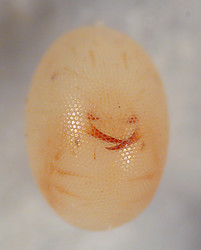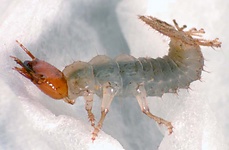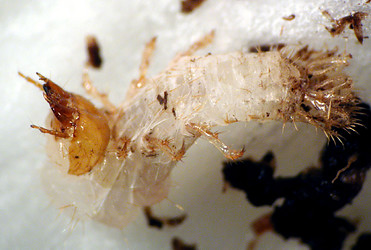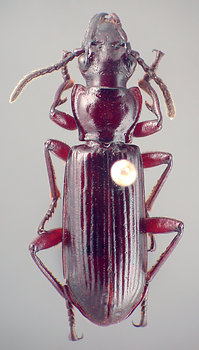Egg


A short movie of the newly hatched larva taking its first few steps:  View Goniotropis kuntzeni egg and first instar larva
View Goniotropis kuntzeni egg and first instar larva
Approximately three weeks after this egg was laid, mandibles of the developing first instar larva are visible through the eggshell - a sign that in the next day or two the egg will hatch. Hardened ridges on the larva's head called egg bursters will help it to break through the shell.
First Instar



Movie of the first instar larva building its burrow:  View Goniotropis kuntzeni first instar larva. Notice how the terminal disk can open and close.
View Goniotropis kuntzeni first instar larva. Notice how the terminal disk can open and close.
Two days after hatching the head of the larva has hardened and darkened in a process known as sclerotization. The larva lives in a burrow which it builds and closes off with its terminal disk. It uses the moveable components of the terminal disk to capture living insect prey which it brings into its burrow to consume.
Molting
Appoximately 50 days after hatching, the first instar sheds its skin, or cuticle, in a process known as molting. The cuticle of the first instar cracks along the dorsal surface and the second instar larva emerges from that fracture. First the head breaks free and then, after approximately a 10 minute struggle, the larva is able to shed the old cuticle from the terminal disk.
Second Instar



Movie of the second instar larva walking:  View Goniotropis kuntzeni second instar larva. Notice how the larva holds its terminal disk up and over its back.
View Goniotropis kuntzeni second instar larva. Notice how the larva holds its terminal disk up and over its back.
Two days after hatching, the head of the second instar larva has hardened and darkened via sclerotization.
Third Instar
The second instar larva will molt one more time to become a third instar larva. The third instar then becomes a pupa.
Pupa
During the pupal stage the beetle uses nutrients acquired during the larval instars and transforms from a larva into an adult.
Adult
This is an adult Goniotropis kuntzeni male. The females of this species look very similar. The males and females mate, the female lays her eggs, and the process begins again.










 Go to quick links
Go to quick search
Go to navigation for this section of the ToL site
Go to detailed links for the ToL site
Go to quick links
Go to quick search
Go to navigation for this section of the ToL site
Go to detailed links for the ToL site